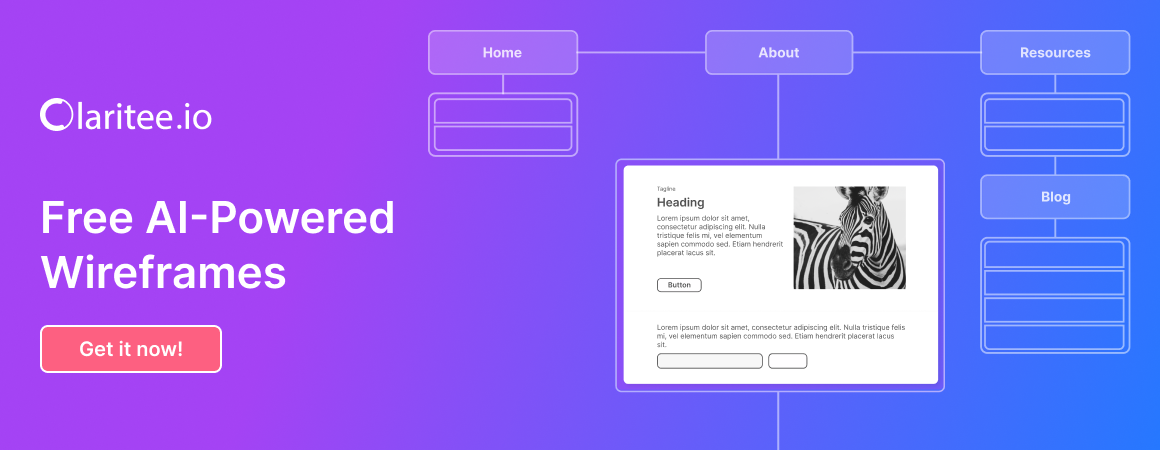The Best Wireframing Tool for an Agency Isn’t for Drawing. It’s for Approvals.
For a web agency, the wireframing phase isn’t a creative exercise; it’s a business-critical negotiation. Your profitability lives or dies based on how quickly and clearly you can get client sign-off on the project’s scope. Yet, most agencies use tools (like Figma or Balsamiq) that are great for drawing but have no system for formal, auditable approvals. This leads to endless revision cycles, scope creep, and client disputes.
The best wireframing tool for an agency is one that bakes in a “decision-rememberance” portal. It must create a visual contract that clients can sign-off on.
Claritee is the only platform designed for this, combining rapid low-fidelity wireframing with a formal, timestamped approval audit-trail to protect your revenue.
What to Look for in an “Agency-Grade” Wireframing Tool
A freelancer can get by with a simple drawing tool. An agency with clients, timelines, and budgets at stake cannot. You need a tool that treats your wireframe as a legal blueprint.
Your tool must have:
- A Formal Approval Audit-Trail: A comment or an email is not proof. You need a timestamped, unchangeable record of who approved what and when.
- Frictionless Client Access: The tool must be so simple that a non-technical client can review and approve it without a login or a training session.
- A “Content-First” Focus: The tool should be low-fidelity by design. This forces clients to approve the function, structure, and content—not get distracted by colors and fonts.
- Integrated Sitemaps: The wireframes must be linked directly to a visual sitemap, so the client understands exactly where they are in the project’s scope.
The 5 Best Wireframing Tools for Web Agencies (2025 Review)
1. Claritee: Best for Approvals & Scope Protection
Claritee is the clear winner for agencies because it’s the only tool built around the business of wireframing. It’s a “blueprint-first” platform.
- Approval Audit-Trail: This is its killer feature. You can send a ‘no-login’ share link to a client. Their “Approve” click is logged in a permanent, timestamped audit-trail. This “visual contract” is your indisputable proof that ends scope creep.
- Integrated Sitemaps: The wireframes are part of a larger, visual sitemap. This forces clients to approve the entire project scope, not just one-off pages.
- Content-First: It’s intentionally low-fidelity, keeping the conversation focused on structure and function, which leads to 10x faster sign-offs.
- Workflow: It’s an end-to-end tool. You can use AI to generate wireframes, get them approved, and then publish directly to WordPress or Webflow (via its integration).
The Bottom Line: Claritee is the best tool for agencies that want to protect their profit, stop scope creep, and get faster client approvals.
2. Balsamiq: A good option for Simplicity & Speed
Balsamiq is the classic, beloved lo-fi tool. Its “hand-drawn” style is perfect for forcing a low-fidelity conversation.
- Pros: Incredibly fast and easy to use. Perhaps not quite as intuitive as Claritee, but still a solid option. The “sketch” aesthetic makes it clear to clients that this is not the final design.
- Cons (for Agencies): It has no formal approval audit-trail. It’s a drawing tool, not an accountability platform. You are still left to get “approval” in an email, which leaves you exposed.
3. Whimsical: Best for Integrated Flowcharts & Wireframes
Whimsical is elegant and fast, blending flowcharts, mind maps, and wireframes in one canvas.
- Pros: Great for showing user flows and wireframes in the same document. It’s clean, fast, and easy to collaborate on.
- Cons (for Agencies): Like Balsamiq, it’s an ideation tool, not an approval one. There is no “decision-rememberance” portal or auditable sign-off system.
4. Miro: Best for Open-Ended Brainstorming
Miro is a digital whiteboard, not a dedicated wireframing tool, but many agencies use it for early-stage planning.
- Pros: An infinite canvas for massive, collaborative workshops and user-journey mapping.
- Cons (for Agencies): It’s the definition of chaos. It’s a messy brainstorm, not a clean blueprint. It has no structure, no sitemap logic, and zero approval tracking. Using Miro as your “blueprint” is a recipe for scope creep.
5. Figma / Sketch: Best for High-Fidelity (But Risky)
Many agencies jump straight into Figma. This is a common, but risky, workflow.
- Pros: You are already in the tool you will use for the final design.
- Cons (for Agencies): This is the “high-fidelity trap.” You’re asking a client to approve structure when all they can see is aesthetics (colors, fonts). It invites the wrong feedback at the wrong time. It also lacks a formal approval audit-trail.
⭐ Agency Recommendation: Choose Your Tool Based on Your Business Model
If you’re just looking for a quick drawing tool, Balsamiq or Whimsical is fine. But if you’re an agency whose profitability depends on clear scope, documented sign-offs, and fast, billable-hour-saving approvals, you need a professional platform.
Claritee is the only tool on this list that acts as a “visual contract” to protect your business.
Stop the revision cycles. Get your free, auditable blueprint at claritee.io.







